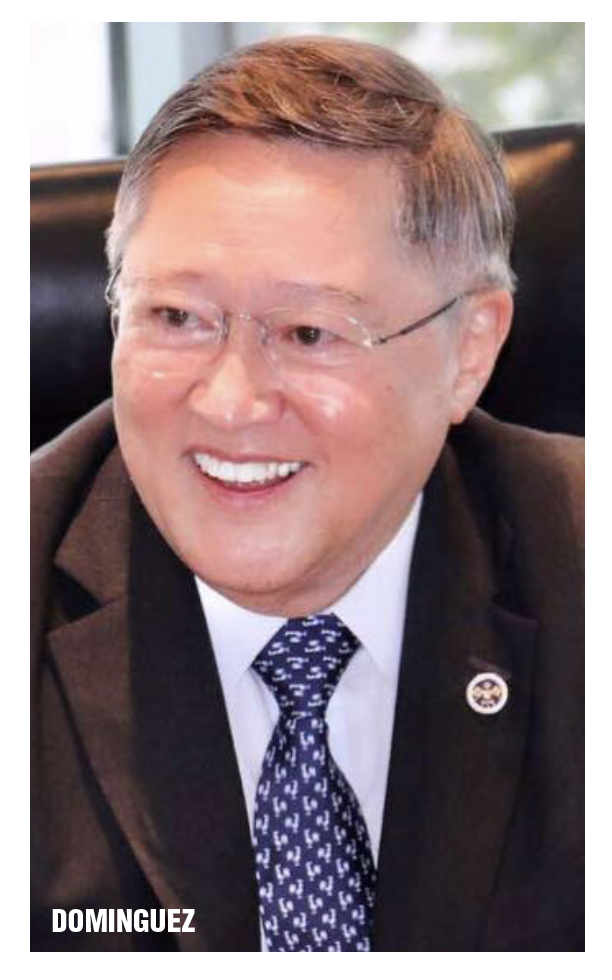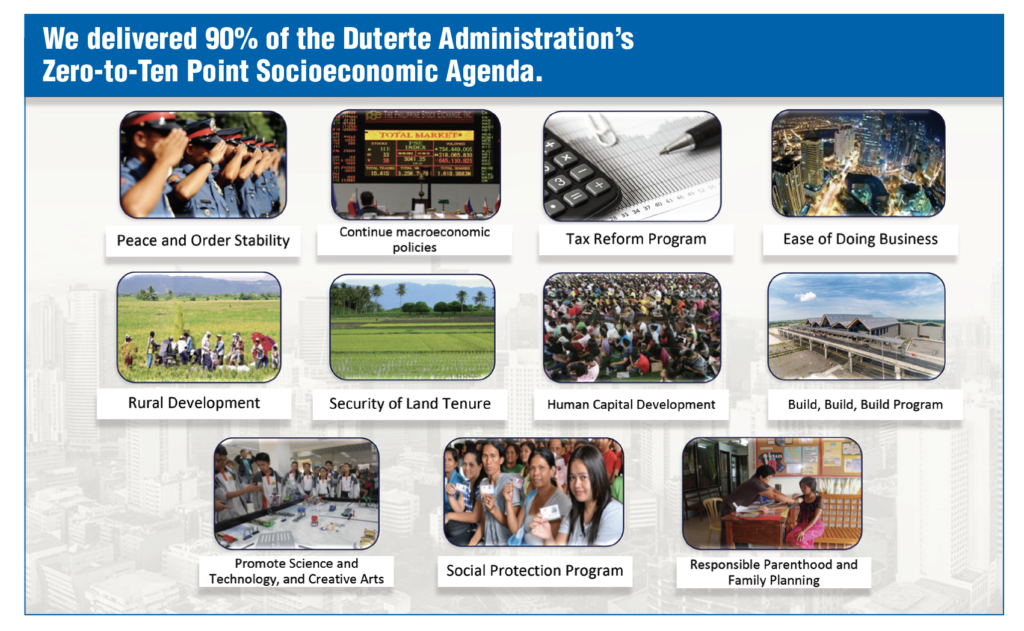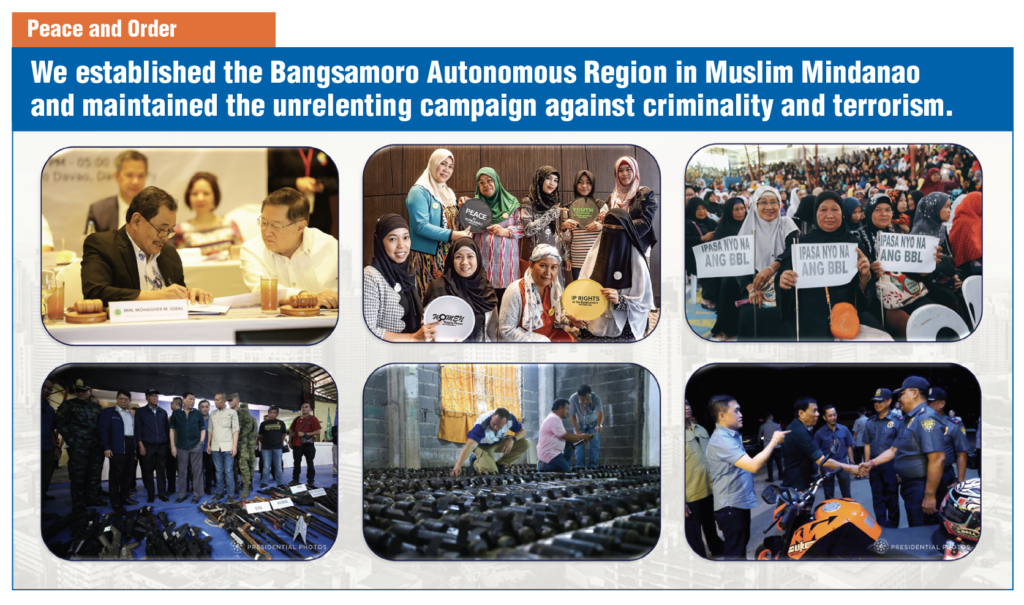By Finance Secretary Carlos G. Dominguez
(Presented during the Philippine Economic Briefing (PEB) held at the Philippine International Convention Center (PICC) in Pasay City, April 5, 2022.)
My fellow colleagues in the Cabinet led by Executive Secretary Salvador Medialdea; Bangko Sentral Governor Benjamin Diokno; members of the diplomatic corps; our reliable bilateral and multilateral partners; business leaders; analysts; investors; economists; fellow workers in government; and friends from the media here and abroad: Good morning.
Years from now, when the Philippines brings down its poverty incidence to single-digits, we will look back to the Duterte presidency as the moment when the country made the turn towards more inclusive growth and prosperity.
When President Rodrigo Duterte took office in 2016, he adopted a bold zero-to-ten-point socio-economic agenda proposed by various stakeholders who participated in our first-ever Sulong Pilipinas. Five and a half years later, we delivered 90% of this ambitious reform program.
Under President Duterte’s term, the Philippines made the decisive shift from an inward-looking economy to one ready to compete with the rest of the world.
Reform measures
Many reform measures that languished for decades on the shelves of Congress were finally enacted into law. I have to thank everyone who contributed to these successes–our legislators, our friends in the private sector, our reliable development partners, and my colleagues in the Cabinet guided by Executive Secretary Salvador Medialdea.
We took a significant step towards lasting peace with the establishment of the Bangsamoro Autonomous Region in Muslim Mindanao. The administration also maintained an unrelenting campaign against criminality and terrorism. The peace and order we now enjoy must be credited to the work of our security, peace, and defense team led by Secretary Delfin Lorenzana, Secretary Eduardo Año, Secretary Hermogenes Esperon Jr., and Secretary Carlito Galvez Jr.
The enactment of the Ease of Doing Business Act paved the way for improved and efficient delivery of public services. I commend the Department of Trade and Industry led by Secretary Ramon Lopez here in front of us for the efficient implementation of this law, which remarkably increased the competitiveness of the country’s business climate.
ID system
We enacted the Philippine Identification System Act which brings us closer to the goal of achieving e-governance and greater financial inclusion among our people. The National Economic and Development Authority led by Secretary Karl Chua has been working tirelessly to accelerate the rollout of this program and immediately reach as many Filipinos as possible.
As of March 23 of this year, a total of 61.3 million individuals nationwide have registered for the national ID. Through this program, the Land Bank of the Philippines has cleared the way for 7.7 million formerly unbanked registrants to be part of the formal banking system.
In addition, we fulfilled President Duterte’s promise of establishing a bank dedicated to the needs of Filipinos working abroad. The Overseas Filipino Bank is our first branchless digital-only bank in the country. It now serves overseas Filipinos in 116 countries.
To further accelerate financial inclusion and broaden the capital markets, the Bureau of the Treasury introduced innovative government securities for small individual investors that can be purchased through digital channels. We also finally implemented the long-dormant Real Estate Investment Trust Act, which has become a powerful financial instrument for the property development sector and small investors.
In just two years of implementation, the total market capitalization size of REITs in the country already reached P269.7 billion.
Meanwhile, the Rice Tariffication Law was finally achieved after more than 30 years of failed attempts under previous administrations. The law opened up the Philippine rice market and, in turn, lowered the price of our country’s staple food for more than 100 million Filipinos. As a result, rice is no longer the main contributor to our overall inflation rate.

Rice Tariffication Law
The Rice Tariffication Law ensures that farmers benefit directly by providing at least P10 billion each year for mechanization, high-quality seeds, access to credit, and training.
Before the law was passed in 2019, the National Food Authority regulated all rice imports and it was the chief importer of the grain. It received an average of P11 billion a year in tax subsidies.
With rice tariffication, the government has already earned a total of P46.6 billion in rice import tariffs during the first three years of its implementation.

These revenues support the reform and modernization of our agriculture sector. This is a complete reversal of the P11 billion annual average tax subsidies the government provided to NFA every year from 2005 to 2018.
The Rice Tariffication law is just one of the progressive efforts undertaken by the Department of Agriculture led by Secretary William Dar to build productivity and enhance the resiliency of our agriculture sector.
The Duterte administration decisively passed and implemented the most comprehensive tax reform program ever in this country. This provided robust and recurring revenues that helped expand social services and supported our massive economic investments in modern infrastructure.
I would like to point out, however, that the success of the tax reform measures cannot be attributed exclusively to the current efforts. This is the logical continuation of the decades of reforms arduously passed by the previous administrations.
Tax Reform
TRAIN or the Tax Reform for Acceleration and Inclusion Act reduced the personal income taxes for 99% of our taxpayers, giving them much-needed relief after 20 years of non-adjustment. Through TRAIN, we have basically given out a 14th-month pay every year to our wage earners.
Under the law, we imposed excise taxes on sweetened beverages from which we collect almost P104 million a day. TRAIN likewise mandated the implementation of our first-ever nationwide fuel marking program to curb oil smuggling.
No past administration increased sin taxes more than once. President Duterte and Congress raised sin taxes three times within his term. The excise taxes on tobacco and alcohol products improved funding for the Universal Health Care Program.
All in all, TRAIN and the other enacted packages of the tax reform program enabled the government to raise P504.6 billion in incremental revenues during the first four years of implementation.
In addition to modernizing our tax policies, the Duterte administration aggressively pushed for the full digitalization of the Bureau of Internal Revenue and the Bureau of Customs. In 2015, only 10% of the country’s taxpayers filed their income tax returns online. In 2021, this grew to 99.5%.
From the 1.9 million electronic payment transactions made with the Bureau of Internal Revenue in 2015, this number rose to 5.5 million electronic payment transactions last year. These figures are projected to dramatically increase in the coming years as we introduce more digitalization initiatives.
Meanwhile, our policy of instilling fiscal discipline among our GOCCs or government-owned or controlled corporations allowed us to collect an average of P68.7 billion annually from these firms since we took office. This is more than double the average annual collection of the past administration.
Through bold tax reforms and better tax administration, we were able to raise our revenue effort to 16.1% of GDP in 2019 from 15.1% in 2015. This was our best performance in more than two decades.

Historic low debt-to-GDP
In 2019, our debt-to-GDP ratio was at a historic low of 39.6% from 42.7% in 2015. The international credit rating agencies recognized us by giving us the best credit ratings ever, ranging from BBB plus to a triple A. As a result, we were able to bring down our borrowing costs and raise bond issuances with very tight spreads in the international markets. This high credit rating also spilled over into the low borrowing costs for the private sector.
Our Samurai, Panda, Euro, and Dollar bonds were all met with strong demand, illustrating the high level of confidence of international investors in the Philippines.
Our robust revenue flow and concessional financing allowed us to sustainably fund the Build, Build, Build program, which is one of the lasting legacies of President Duterte.
This administration was able to raise infrastructure spending to above 5% of GDP, double the level recorded by the previous four administrations. This would not have been possible without the hard work of our infrastructure implementing agencies led by Secretary Arthur Tugade, former Secretary Mark Villar, Secretary Vince Dizon, and Acting Secretary Roger Mercado.
Railway system
The Philippine railway system is illustrative. After many decades of neglect, the country had only 77 kilometers of rail service by the time the Duterte administration took office. Today, we have 1,209 kilometers of rail service.
From only 61 operational stations, this will increase to 208 by the end of this year. In 2016, we had only 224 operational train cars. This has now increased to 1,386. Life is now more comfortable as Filipinos can now travel more conveniently with an increasingly expansive and efficient railway system.
Our fiscal discipline encouraged our development partners to support our infrastructure program through concessional loans and grants. Since we took office, we sealed 28 highly concessional loan agreements for our flagship infrastructure projects. This includes the country’s most ambitious infrastructure undertaking–the Metro Manila Subway project. With the generous support of Japan, what has once been considered a dream subway is now about to become a reality.
Apart from infrastructure, the Duterte administration also invested heavily in social services to boost human capital development. We provided health care coverage, housing, unconditional cash transfers, quality jobs, free education in state colleges and universities, and free irrigation water.
These programs were all efficiently carried out by the implementing agencies led by Secretary Leonor Briones, Secretary Rolando Joselito Bautista, Secretary Francisco Duque, Secretary Eduardo del Rosario, Secretary Silvestre Bello III, Secretary Bernadette Puyat, and National Irrigation Administrator Ricardo Visaya.
I also have to thank the Department of Budget and Management first led by Ben Diokno and now led by Officer-in-Charge Tina Canda for ensuring the equitable, prudent, transparent, and accountable allocation and use of public funds for these social services and infrastructure projects.
To better serve the needs of the Filipino people, the Duterte administration has infused the largest amount of capital into the Land Bank of the Philippines and the Development Bank of the Philippines compared with the combined amounts under all past administrations.
Land Bank
When we assumed office, Land Bank had only P88.7 billion in capital while DBP had P37.9 billion. By the end of April 2022, Land Bank’s capital will now be P230.4 billion, making it the second-largest universal bank in the country. DBP’s capital will now be P76.9 billion.
In particular, Landbank’s image as a big rural bank is far in the rearview mirror. The robust capital infusion reinforced Land Bank’s financial strength and allowed it to be an effective partner of the government in advancing its development agenda.
The capital is being prudently managed and used to finance projects that are most needed by the country, not just in the agriculture sector. Land Bank is also the biggest lender to the local government units.
Other sectors being supported by the Bank include healthcare, education, power generation and distribution, water, transportation, and housing—all led by the private sector.
The capital is being prudently managed and used to finance projects that are most needed by the country, not just in the agriculture sector. Land Bank is also the biggest lender to the local government units.
Other sectors being supported by the Bank include healthcare, education, power generation and distribution, water, transportation, and housing—all led by the private sector.
These game-changing measures and programs made the Philippines one of the economic leaders in the region, growing over 6% annually. The same reforms helped us gain the financial strength to weather the worst of the COVID-19 crisis.
Had we not pursued them on time, the impact of the pandemic would have been worse. Our 2020 GDP would have plunged deeper by 13.3% instead of 9.6% . This just only proves that in any battle or emergency, preparation is always the best strategy.
When COVID-19 struck, the Duterte administration moved quickly to protect Filipino lives. The Philippines’ direct response to the COVID-19 crisis so far amounted to P3 trillion, equivalent to 15.6% of our GDP. Funding our social protection and economic stimulus measures has been a challenge. But the pandemic found us in a strong financial and fiscal position, ready to protect our citizens.
The government collected lower revenues due to the lockdown that slowed down economic activity. At the same time, we needed more money to fund the unexpected costs of the pandemic. Fortunately, we had the fiscal headroom to temporarily increase our deficit to GDP ratio of 3.4% in 2019 to 7.6% in 2020 and 8.6% in 2021.
Clear strategy for deficit financing
We had set out a clear strategy for financing our deficit. We prioritized domestic borrowings followed by official development assistance and then, and lastly, international capital markets. We determined this plan as the most prudent approach, ensuring sustainability in our debt service.
(more at page 18)
